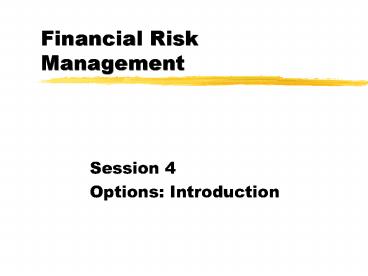Financial Risk Management PowerPoint PPT Presentation
1 / 22
Title: Financial Risk Management
1
Financial Risk Management
- Session 4
- Options Introduction
2
T-shirt example again
- Recall the T-shirt example in session one.
- Need to purchase dollars (sell yen) in months
time. - The forward contract fixed a rate for us.
- But now you want to keep the gains if the yen
appreciates but avoid losses from a depreciating
yen.
3
Gain/Loss
Avoid this
Keep this
0
45deg
spot rate in 1 month
125
-
4
Options (?????)
- The right (??) but not the obligation to
purchase/sell the underlying asset at
prespecified price at a prespecified date (or
before). - The right to purchase is a call option.
- The right to sell is a put option.
- Prespecified price is the exercise price or
strike price (??????????).
5
Cont.
- American vs European Options
- American option Exercise anytime before and at
maturity(????????????). - European option Exercise only at maturity.
- ASIAN options
- Long position (hold), short position (sell or
write)
6
Long (European) Call
- You purchased (hold) a contract which gives you
the right but not the obligation to purchase the
underlying asset. - Assume the strike price is 100.
- If the underlying asset price is 50 at maturity,
will you exercise the option? - If the underlying asset price 150 at maturity,
will you exercise the option?
7
Payoff
S-X
ST Asset Price at Maturity
X 100
Long Call
8
Long Call
Payoff
50
S-X150-10050
0
150
ST
X 100
Exercise
Not exercise
9
Payoff
- If the underlying asset is 150 at maturity, use
the contract (exercise) to buy the stock at 100.
Then sell the stock at 150 in the market. The
payoff to you is 50 (assume no taxes, fees,
etc.). - If the underlying asset is 50. Most people would
not use the contract. It is better to purchase
the stock directly from the market at 50 instead
of using the contract (price at 100). Thus, the
contract is of no value to you.
10
Short Call and Long Put
Payoff
ST
X
11
Profit Diagram
Option Premium (price of contract) ??????????
profit
premium
ST
X
Premium price of contract-investor
purchases call contract for this price.
12
For Call
Near the Money
Out of the Money
In the Money
ST
X
Deep-out-of- the Money
Deep-in- the Money
At-the- Money
13
Reading the Paper
Strike price Near Maturity Far
Maturity X1 price price X2 price price X3
price price X4 price price X5 price price
14
Stock Index Option Quotes in the Nikkei Weekly
Nikkei stock average index option traded on the
Osaka Exchange. 1) Notice the option price for
calls declines uniformly with an increase in the
strike price. The reverse for puts. 2) Notice
the option price increases with maturity date
further in the future.
X1gtX2 C(X1)ltC(X2) P(X2)ltP(X1) c(X1)ltc(X2)
p(X2 )ltp(X1)
T2gtT1 C(T2)gtC(T1) P(T2)gtP(T1 )
15
What is the effect of an increase in the
determinant variable on the premium?
Specified in Contract
call premium c( X, T-t, S, r,
volatility)
-
Forecast
Observe in market
put premium c( X, T-t, S, r,
volatility) - -
16
What is an employee (executive) stock option?
- The employee stock option is a contract given to
employees of the firm as a form of compensation
(income/bonus). - The contract gives the employee the right but not
the obligation to purchase shares of stock of the
firm they are working for. The price is
pre-determined and is referred to as the exercise
or strike price. The contract is usually long
term - in years. - The contract usually does not allow the employee
to purchase the stock immediately. The employee
must wait several months to several years
(depending on the contract). - The contract cannot be sold to another person.
17
Payoff DiagramBasically a Call Option
Payoff of Option
S-X
S (Stock Price at Maturity)
X exercise or strike price
No Gain
GainS-X
18
Benefits of Stock Options
- Risk Sharing.
- Incentive for performance stock price movements
tied to firm performance in the medium/long-run. - A cheap form of compensation for small firms
which cannot afford to pay in cash Silicon
Valley type firms. - Employee stock options People feel they are part
of the team.
19
Source Businessweek
20
Some Weaknesses
- How much control does the average employee have
over stock prices? Especially in large firm? - Will executives receiving such benefits venture
into riskier business to simply capture the
potential upside growth? - General market conditions.
- Effect on employee moral in poor market
conditions. - Do the executives already have a large amount of
the firms equity before receiving the options?
21
Stock Options From June 1, 1997
- Share-buyback (repurchase) type stock option
The firm buys back shares from the market. These
shares are then sold to the executive
(employee) exercising the option. - New-issue type stock option New shares are
issued each time the option is exercised. - In general, no more than 10 of the firms
outstanding shares can be sold in the form of
stock options.
22
Case Questions
- Read thru questions at the end of the case and be
prepared for discussion. - Make sure you understand the diagram (prepared to
discuss) depicting payoff of various strategies.

